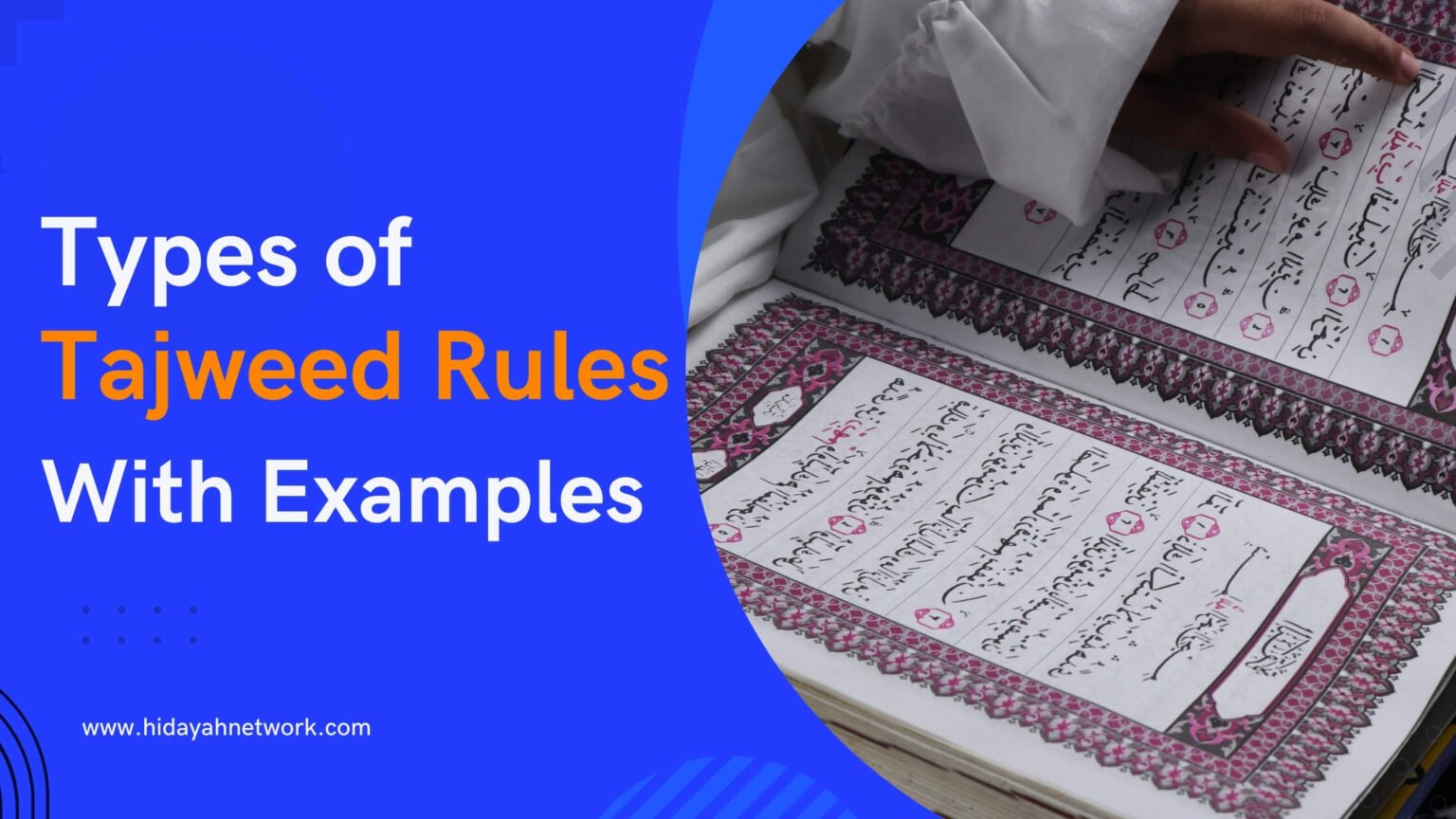Learning the Tajweed rules is extremely vital to ensure the Quran is recited and read in the way that it should be. In total, there exist 12 Tajweed rules and each one has its distinct application in the Quran.
Today, we will learn all there is to know about Tajweed rules, ensuring beautiful recitation of Quran that brings you ever so close to Allah (SWT).
Listed below are the 12 types of tajweed rules:
- Al-Isti’aathah & Al-Basmalah
- Noon Saakin and Tanween
- Meem Sakinah
- Al-Madd
- Qalqalah
- Tarqeeq and Tafkheem
- Noon and Meem Mushaddad
- Muldood
- Waqf and Ibtida
- Ghunnah
- Sifaat-al-Huroof
- Makharij-al-Huroof

1. Al-Isti’aathah & Al-Basmalah
Al-Isti’aathah الاستعاذة, often termed as “Seeking Refuge,” entails reciting “A’udhu billahi min ash-shaytan ir-rajim” before beginning the recitation of the Quran. In simple terms, it signifies seeking Allah’s protection from the accursed devil. Reciting Al-Isti’aathah serves as a practice to seek refuge and assistance from Allah before engaging with the sacred text.
Al-Basmalah البسملة comprises the phrase “Bismillah al-Rahman al-Rahim,” translating to “In the name of Allah, the Most Gracious, the Most Merciful.” It is recited at the onset of most chapters (Surahs) of the Quran.
There are 6 Rules of Al-Isti’aathah and Al-Basmalah:
- Reciting “Seeking Refuge” once suffices for the entire Quran, although it’s recommended to recite it at the beginning of each surah.
- Commence every surah with “In the name of Allah” (Basmalah), except for Surah Al-Tawbah.
- Within a surah, the decision to recite Basmalah is optional, although it’s considered better to include it.
- At the commencement of a surah, you can combine “Seeking Refuge” with Basmalah.
- Between two surahs, Basmalah can either be joined with the previous surah or omitted, but it should not be both.
- Surah Al-Tawbah does not begin with Basmalah; reciting “Seeking Refuge” suffices.
Get 40% OFF Now!
2. Noon Saakin and Tanween
Noon Sakinah is a Tajweed rule focusing on the accurate pronunciation of the Arabic letter “ن” (noon) when it carries a sukoon (quiescent or stop) mark. “Nunation” describes the spelling modification Tanween made to the term. In certain contexts, tanween signals append the sound “n” to the end of words. Proper application of Noon Saakin and Tanween rules ensures precise recitation of Quranic verses, avoiding errors or alterations in meaning.
Example of Noon saakin and tanween, from the Quran, In Surah Al-Fatihah (1:7), the verse “وَإِيَّاكَ نَسْتَعِينُ” (And You alone we ask for help) contains a Noon Sakinah followed by the letters “سْتَ.” According to Tajweed rules, when Noon Sakinah is followed by “سْتَ” or any other letter, it undergoes Ikhfaa.
There are 4 important Rules of Noon Sakinah:
- Izhar: Izhar refers to the clear and distinct pronunciation of Noon Saakin or Tanween without assimilation, making the sound evident and unaltered.
- Iqlab: Iqlab occurs when the letter “Baa” (ب) follows Noon Saakin or Tanween, leading to a distinct change in sound, resembling a “B” pronunciation.
- Idghaam: Idghaam involves merging Noon Saakin or Tanween with the following consonant, softening the transition and blending the two sounds smoothly.
- Ikhfaa: Ikhfaa is the concealment of Noon Saakin or Tanween, where the sound is subtly assimilated with the following consonant, creating a muted or hidden pronunciation.
3. Meem Sakinah
Meem Sakinah denotes a specific scenario in Arabic pronunciation where the letter Meem (م) is in a state of sukoon (sakinah), representing a complete cessation of sound. This phenomenon occurs either at the end of a word or within a word when Meem is followed by another letter.
Example of Meem Sakinah from the Quran, In Surah Al-Furqan (25:4). Allah addresses those who disbelieve, stating, “وَقَالَ الَّذِينَ كَفَرُوا إِنْ هَٰذَا إِلَّا إِفْكٌ افْتَرَاهُ وَأَعَانَهُ عَلَيْهِ قَوْمٌ آخَرُونَ ۖ وَقَدْ جَاؤُوا ظُلْمًا وَزُورًا” (And those who disbelieve say, “This [Quran] is not but a falsehood he invented, and another people assisted him in it.”).
In the word “إِفْكٌ” (ifkun), the Meem is in a state of sukoon, indicating Meem Sakinah. Here, Meem Sakinah is followed by the letter Qaf (ق), and proper pronunciation involves a brief pause or cessation of sound on the Meem before transitioning to the next letter.
There are 3 rules of Meem Sakinah below:
- Al-Idgham Al-Shafawi: Al-Idgham Al-Shafawi occurs when a Meem Sakinah is followed by another Meem. In this scenario, the pronunciation involves blending the two Meems together, creating a nasal sound (Ghunnah).
- Al-Iqlab Al-Shafawi: Al-Iqlab Al-Shafawi occurs when a Meem Sakinah is succeeded by the letter “Ba” (ب). In this case, there is a pronounced assimilation of the two sounds, with a nasal tone (Ghunnah).
- Al-Izhar Al-Shafawi: In Al-Izhar Al-Shafawi, when a Meem Sakinah is followed by any other letter except another Meem or “Ba,” it is pronounced distinctly without assimilation. There is no blending of sounds, and no nasal sound (Ghunnah) is produced.
4. Al-Madd
Al-Madd, a Tajweed rule, refers to the elongation of specific letters in Quranic recitation. This elongation is essential for maintaining the correct rhythm and melody while reciting the Quran.
An example of Al-Madd is found in Surah Al-Falaq (113:5), where the elongation of the letter “ق” (Qaf) in the word “الْفَلَقِ” contributes to the melodious recitation of the verse.
The elongation symbolizes the emphasis and significance of the letter within the verse, enhancing the beauty and rhythm of the recitation.
5. Qalqalah
Qalqalah is a Tajweed rule enriching Quranic recitation by infusing a subtle bouncing or echoing sound into specific Arabic letters when they carry a sukoon (quiescent or stop) mark. This technique adds rhythm, emphasis, and musicality to the recitation, enhancing the Quran’s eloquence and beauty.
Qalqalah applies to five Arabic letters:
- “ق” (qaf)
- “ط” (taa)
- “ب” (baa)
- “ج” (jeem)
- “د” (dal)
When any of these letters bear a sukoon, they should be pronounced with a gentle bounce or echo effect, creating a subtle vibration in the recitation.
6. Tarqeeq & Tafkheem
Tafkheem is a Tajweed principle focusing on accentuating heavy letters, referred to as Mufakhkham. These letters demand a more pronounced emphasis during recitation, filling the mouth with their resonant echo. Notable heavy letters include Taa (الطاء), Dhaad (الضاد), Saad (الصاد), Dhaa (الظاء), Qaaf (القاف), Ghain (الغين), and Khaa (الخاء).
- Definition: Tafkheem involves strengthening the pronunciation of heavy letters in Arabic, imparting them with added emphasis.
- Rules: Heavy letters require a more prominent articulation during recitation, resonating within the mouth with their distinct echo.
- Examples:
- Taa (الطاء): Pronounced with a forceful emphasis, as in the word “تَقْطِيعٌ” (cutting).
- Qaaf (القاف): Emphasized heavily to convey its resonance, as in “قَوْمٌ” (a people).
Tarqeeq (تَرْقِيق): Lightening Pronunciation
Tarqeeq, contrasting with Tafkheem, pertains to lightening the pronunciation of letters, termed Muraqqaq. These letters are articulated with less emphasis compared to their heavy counterparts, contributing to a softer tone in recitation.
- Definition: Tarqeeq involves softening the pronunciation of letters, particularly those that are not heavy, according to Tajweed rules.
- Rules: Light Tajweed letters are pronounced with reduced emphasis, creating a softer tone in recitation and contrasting with the heavy letters emphasized in Tafkheem.
- Examples:
- Seen (السين): Articulated softly, as in the word “سُرُورًا” (joy).
- Ha (الهاء): Pronounced lightly to convey its gentleness, as in “هُدًى” (guidance).
There are 3 Letters with Variable Emphasis:
Alif (ا), Lam (ل), and Ra (ر) exhibit variable emphasis depending on the context, contributing to the nuanced pronunciation in Tajweed.
- Alif: Its heaviness varies based on the preceding letter, being heavy after a heavy letter and light after a light one.
- Lam: Pronounced heavy with Dumma (ُ) or Fatha (َ) and light with Kasra (ِ).
- Ra: Maintains a moderate emphasis level but may become slightly heavier with a preceding Fatha (َ).
7. Noon and Meem Mushaddad
Noon and Meem Mushaddad are Tajweed rules governing the pronunciation of certain Arabic letters when accompanied by a Shaddah (ّ), a diacritical mark indicating the doubling of the consonant’s sound.
When a Noon (ن) carries a Shaddah, it is pronounced with a prolonged nasal sound, similar to the English “nn” in “unnecessary.” For example, in the word “مُنَّافِقُونَ” (hypocrites) in Surah Al-Baqarah (2:8), the Noon with Shaddah is elongated, emphasizing the doubled nasal sound and distinguishing it from a regular Noon.
Similarly, Meem (م) with a Shaddah undergoes an elongated pronunciation, producing a prolonged nasal sound akin to the English “mm” in “hammer.” For instance, in the word “سَمَّاءٌ” (sky) found in Surah Al-Mulk (67:3), the Meem with Shaddah is elongated, highlighting the doubled nasal pronunciation.
8. Muldood
Muldood refers to the elongation of specific vowels in Arabic pronunciation, particularly Alif (ا), Ya (ي), and Waw (و). This elongation is denoted by a written symbol called Maddah placed over the respective letter.
Example of Muldood from the Quran, In Surah Al-Muzzammil (73:4) Allah commands the Prophet Muhammad (peace be upon him), saying, “أَوْ زِدْ عَلَيْهِ وَرَتِّلِ الْقُرْآنَ تَرْتِيلًا” (Or add to it, and recite the Quran with measured recitation). In the word “تَرْتِيلًا” (with measured recitation), the Ya (ي) is elongated (Muldood) with a Maddah symbol (ٓ) placed above it.
9. Waqf and Ibtida
Waqf and Ibtida’ are essential Tajweed rules governing the pausing and starting points when reciting the Quran. Waqf involves knowing when to pause at specific points within the Quranic text, while Ibtida’ dictates where to begin recitation.
Example of Waqf and Ibtida from the Quran, In Surah Al-Fatiha (1:1-2) the beginning of the Quran, the phrase “بِسْمِ اللَّهِ الرَّحْمَٰنِ الرَّحِيمِ” (In the name of Allah, the Most Gracious, the Most Merciful) marks the Ibtida’ (starting point) of the chapter. It’s customary to Waqf briefly after reciting this phrase, signifying the beginning of recitation with the name of Allah, the Most Merciful, the Most Compassionate, before proceeding with the rest of the chapter.
10. Ghunnah
Ghunnah is a Tajweed rule that introduces a nasal sound when specific Arabic letters are followed by certain nasal letters. This rule ensures accurate pronunciation and contributes to the melodious recitation of the Quran.
Example of Ghunnah from the Quran, In Surah Al-Fil (105:5), Allah describes the fate of the people of the elephant, saying, “فَجَعَلَهُمْ كَعَصْفٍ مَّأْكُولٍ” (So He made them like eaten straw). Here, in the word “مَّأْكُولٍ” (ma’koolin), the Meem Sakinah (مْ) is followed by another Meem, leading to Al-Idgham Al-Shafawi. This combination results in a nasal sound (Ghunnah) in the pronunciation of the combined Meems, creating a distinct and harmonious resonance in the recitation.
11. Sifaat-al-Huroof
Sifaat al-Huroof, also known as Attributes of Letters, is a crucial aspect of Tajweed that delves into the unique characteristics of Arabic letters. Each letter possesses specific attributes that significantly impact its pronunciation, including qualities like heaviness (tafkhim), lightness (tarqiq), elongation (madd), and other distinctive features.
Example of Sifaat-al-Huroof from the Quran, In Surah Al-Baqarah (2:197), Allah instructs regarding the Hajj pilgrimage, saying, “وَأَذِّنْ فِي النَّاسِ بِالْحَجِّ” (And announce to the people the Hajj [pilgrimage]; they will come to you on foot and on every lean camel; they will come from every distant pass). Here, the letter “ق” (Qaf) in “الْحَجِّ” is pronounced with Tafkheem (emphasis), emphasizing the significance of the Hajj pilgrimage.
Two Types of Sifaat-Al-Huroof
1. Sifaat Mutadaaddah (Continuous Attributes)
Sifaat Mutadaaddah refers to the characteristics of letters that allow for the continuous flow of breath when pronounced. Remembered with the phrase “فحثه شخص سكت,” these ten letters, known as whisperers, facilitate smooth and uninterrupted pronunciation without causing a break in the breath. Examples include فَ (fa), حَ (ha), and شَ (sheen).
2. Sifaat Ghayr Mutadaaddah (Discontinuous Attributes)
Sifaat Ghayr Mutadaaddah involves letters where the breath is discontinued during pronunciation, characterized by a clear vibration of the vocal cords. The quality of jahr, or loudness, is found in the remaining 19 letters, known as majhoorah, including ع (ain), ظ (dha), and غ (ghain).
12. Makharij-al-Huroof
Makharij al-Huroof, often translated as the “points of articulation,” is a fundamental concept in Tajweed, the science of Quranic recitation. These points denote the specific places in the mouth and throat from which Arabic letters originate.
A thorough understanding of Makharij al-Huroof is essential for accurate Quranic recitation, as each letter’s pronunciation is determined by its point of origin.
Example of Makharij-al-Huroof from the Quran, In various Quranic verses, we can find examples illustrating Makharij al-Huroof. For instance, consider the word “قلب” (qalb), meaning heart, mentioned in Surah Al-Baqarah (2:7). The letter “ق” originates from the back of the throat, while “ل” (lam) is articulated from the tip of the tongue. This distinction in the point of articulation affects the pronunciation of each letter.
Another example can be observed in Surah Al-Falaq (113:5), where Allah says, “قُلْ أَعُوذُ بِرَبِّ الْفَلَقِ” (Say, “I seek refuge in the Lord of Daybreak”). The letter “ق” (Qaf) in the word “الْفَلَقِ” originates from Al-Jawf, the hollow of the throat. Proper pronunciation of Qaf from this area is crucial for maintaining the integrity of the recitation.
5 Types of Makharij-Al-Huroof:
- Al-Jawf: Al-Jawf is the area deep within the throat where certain letters originate. Examples include Alef (ا) and Hamzah (ء).
- Al-Halq: Al-Halq refers to the part of the throat where the sound of some Arabic letters is produced. Examples include Ha (ح), ‘Ain (ع), and Ghain (غ).
- Al-Lisaan: Al-Lisaan denotes the tongue, and certain Arabic letters are pronounced with its involvement. Examples include Qaf (ق), Kaf (ك), and Noon (ن).
- Ash-Shafataan: Ash-Shafataan involves the two lips, with certain Arabic letters pronounced by bringing them together. Examples include Ba (ب), Meem (م), and Waw (و).
- Al-Khayshoom: Al-Khayshoom refers to the nasal cavity, with certain Arabic letters pronounced through the nose. Examples include Noon (ن) when accompanied by a Tanween (ًٌٍ) and Meem (م) when accompanied by a Shaddah (ّ).
What are Tajweed Rules?
Tajweed rules are guidelines for reciting the Quran with proper pronunciation and intonation. They ensure the accurate delivery of each letter and sound, maintaining the beauty and authenticity of the Quranic text.
The 12 rules cover aspects like elongation, proper pronunciation, and characteristics of letters. Applying Tajweed enhances clarity, understanding, and spiritual connection while reciting the Quran.
For example, it dictates how long to stretch certain vowels or when to merge or differentiate between specific sounds. By following the Tajweed, readers honor the sacredness of the Quran and convey its message effectively. That’s why we highly recommend you to learn Quran with Tajweed to fulfill the Quran’s essence.
What are Tajweed Symbols in the Quran?
Tajweed symbols in the Quran are marks and notations used to indicate the correct pronunciation and recitation of the text according to the rules of Tajweed.
Tajweed is the set of rules governing the proper articulation and pronunciation of the Arabic letters and words in the Quran. These symbols serve as a guide for readers to observe the proper characteristics of each letter, such as elongation, pronunciation, and emphasis.
Here are 3 common Tajweed symbols:
- Sajda: A symbol indicating a verse where prostration (sujood) is required, often found at the end of certain verses. When encountered during recitation, it prompts Muslims to perform a brief act of worship, bowing in reverence to Allah.
- Waqf-e-Taam: A stopping point where a complete pause is required during Quranic recitation. It signals a mandatory pause, ensuring proper understanding and reflection on the verse.
- Waqf-e-Lazim: Waqf-e-Lazim is one of the Tajweed symbols in the Quran where pausing is necessary. It denotes a crucial juncture where pausing is obligatory for comprehension and reflection on the meaning of the text.
Why are Tajweed Rules Important in the Quran?
Let’s dwell into the importance of Tajweed rules in the Quran:
- Mastering Tajweed ensures that each word of the Quran is pronounced accurately, preventing any alterations in meaning due to mispronunciation.
- Tajweed offers believers the opportunity to connect with the Quran on a deeper level. It is believed that the Quran will intercede for those who recite it with proficiency on the Day of Resurrection.
- Reciting the Quran with Tajweed is a means of earning immense rewards from Allah. Each letter recited correctly is multiplied in reward, signifying the boundless generosity of Allah.
Through Tajweed, individuals develop a closer bond with Allah.
How to learn Tajweed?
Here are 6 tips that will help you with your questions how to learn tajweed easily:
- Seek guidance from experienced Tajweed instructors.
- Dedicate consistent time to practice Tajweed rules.
- Utilize online tutorials, books, and audio recordings.
- Master pronunciation of each Arabic letter.
- Emphasize clarity over speed.
- Request corrections from knowledgeable individuals or tutors.
Understand that mastering Tajweed takes time and effort.
How long does it take to learn Tajweed?
Learning Tajweed typically takes between 6 to 9 months for beginners. However, the duration varies depending on individual progress. On average, a child can grasp the basics of recitation within a year by dedicating 2 hours per week to lessons and consistent practice at home.
While some may progress faster, others might require more time to achieve proficiency. Consistency, practice, and commitment play crucial roles in mastering Tajweed effectively.
Is it wrong to read the Quran without Tajweed?
Reading the Quran without Tajweed is not considered wrong or forbidden. Tajweed helps improve pronunciation and ensures accurate quran recitation, but it’s not mandatory. It simply aids in correctly articulating each word.
Therefore, there’s no issue with reading the Quran without Tajweed, as there’s no specific requirement mentioned in the Quran regarding Tajweed. It’s more about personal improvement in qurna recitation rather than a strict obligation.
Final Words
The acquisition of Tajweed rules is not merely a skill but a profound connection with the sacred text of the Quran. These types of tajweed rules, which govern the precise pronunciation and melodious recitation of Quranic verses, hold immense significance for beginners and seasoned learners. Beginners can master tajweed rules in 6 months easily after concentrating and showing complete interest.
Mastering Tajweed through platforms like Hidayah Network ensures adherence to Quranic recitation principles and deepens spiritual engagement and understanding.
Frequently Asked Questions
Reading the Quran correctly involves learning Arabic pronunciation and Tajweed rules. Seek guidance from qualified teachers, practice regularly, and utilize resources like books and online tutorials for improvement.
Tajweed ensures accurate Quranic recitation, preserving its original form and meaning. Proper pronunciation enhances understanding, respects the sacred text, and maintains its beauty and authenticity.
Tajweed has 12 main types, focused on proper pronunciation and recitation rules. However, various methods and schools of thought may exist within Tajweed instruction, each emphasizing different aspects of correct recitation.
Lorem ipsum dolor sit amet, consectetur adipiscing elit, sed do eiusmod tempor incididunt ut labore et dolore magna aliqua. Ut enim ad minim veniam, quis nostrud exercitation ullamco laboris nisi ut aliquip ex ea commodo consequat.

About Author

